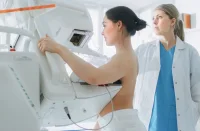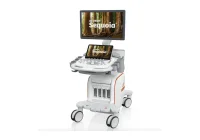Mammography screening is essential for early detection of breast cancer, significantly improving treatment outcomes and survival rates. Traditionally, double reading—where two radiologists independently review mammograms—is considered the gold standard to enhance diagnostic accuracy. However, with increasing workloads and radiologist shortages, artificial intelligence (AI) is gaining attention as a tool to alleviate the burden without compromising quality. A recent study published in Radiology: Artificial Intelligence discusses a study that explores the feasibility of AI integration in mammography screening and its potential to replace or augment the current double reading process.
AI's Role in Screening Workflows
The study focused on three AI-integrated screening scenarios, simulating the replacement of either one or both radiologists in double reading. In Scenario 1 (AI replacing the first reader), Scenario 2 (AI replacing the second reader), and Scenario 3 (AI as a triage tool), the performance of AI was compared with traditional double reading. The key objective was to maintain, or ideally enhance, cancer detection accuracy while significantly reducing the volume of screen readings.
The results of Scenario 1 indicated that replacing the first reader with AI maintained the cancer detection rate (CDR) without significantly impacting overall accuracy, though arbitration rates increased. Scenario 2, where AI replaced the second reader, slightly reduced sensitivity, but positive predictive values (PPVs) improved, suggesting fewer unnecessary recalls. Scenario 3, the triage approach, provided the best balance, with a slight increase in sensitivity, higher PPV, and fewer arbitrations.
Workload Reduction and Accuracy Trade-Offs
A crucial aspect of the study was to determine the extent to which AI integration could reduce radiologists' workloads. Across all three scenarios, a reduction of approximately 50% in the number of screen readings was observed. This is a substantial improvement, given the growing demand for mammography services and the limitations posed by the shortage of qualified radiologists.
Scenario 3, the AI-triage system, emerged as the most promising in balancing workload reduction and diagnostic accuracy. In this scenario, AI autonomously classified mammograms into low-, moderate-, and high-risk categories. The moderate-risk cases, which accounted for half of the total mammograms, were read by radiologists, while the AI handled the remaining low- and high-risk cases independently. This approach not only reduced the number of readings but also optimised the radiologists' focus on more challenging cases, enhancing efficiency without compromising accuracy.
AI's Impact on Cancer Detection Rates
Cancer detection rates (CDRs) are critical to a screening program's success. The study found that AI integration did not significantly lower CDRs, with Scenario 3 showing the highest detection rate among the AI-integrated models. While Scenario 2, where AI replaced the second reader, showed a slight dip in sensitivity, this was offset by a reduction in false positives, as indicated by a higher PPV. False positives can lead to unnecessary recalls, causing patient anxiety and increasing healthcare costs.
In the context of cancer subtypes, AI demonstrated comparable performance to radiologists in detecting invasive ductal carcinoma, the most common form of breast cancer. The AI-triage system also performed well in identifying smaller tumours, which are often harder to detect but critical for early-stage intervention.
However, AI struggled to detect interval cancers—those that develop between regular screenings. Interval cancers are often more aggressive and difficult to catch through routine screening. In all three AI-integrated scenarios, interval cancer detection was lower than with human readers, highlighting an area where further refinement of AI algorithms is needed.
Conclusion
The integration of AI into mammography screening workflows offers a feasible solution to the challenges faced by healthcare systems, including radiologist shortages and increasing workloads. While replacing a single reader with AI, particularly in Scenario 1, showed promise, the triage approach (Scenario 3) proved to be the most effective in balancing workload reduction and diagnostic accuracy.
AI integration, especially as a triage tool, could lead to significant efficiency gains without compromising the quality of care. However, ongoing research and prospective trials are necessary to address concerns, such as the detection of interval cancers, and to explore the long-term impact of AI on patient outcomes. As technology advances and AI systems become more sophisticated, they are likely to play an increasingly important role in breast cancer screening, offering a way to ensure widespread, high-quality screening even in the face of resource constraints.
Source: Radiology: Artificial Intelligence
Image Credit: iStock










